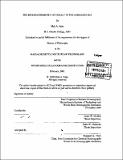The biogeochemistry of cobalt in the Sargasso Sea
Author(s)
Saito, Mak A
DownloadFull printable version (12.91Mb)
Other Contributors
Woods Hole Oceanographic Institution.
Advisor
James W. Moffett and Sallie W. Chisholm.
Terms of use
Metadata
Show full item recordAbstract
Processes that enable marine phytoplankton to acquire trace metals are fundamental to our understanding of primary productivity and global carbon cycling. This thesis explored the biogeochemistry of cobalt using analytical chemistry and physiological experiments with the dominant phytoplankton species, Prochlorococcus. A high sensitivity method for Co speciation was developed using hanging mercury drop cathodic stripping voltammetry. Dissolved Co at the Bermuda Atlantic Time Series station (BATS) in the Sargasso Sea was bound by strong organic complexes with a conditional stability constant of logK=16.3+0.9. A depth profile of Co at BATS revealed a nutrient-like profile. Biweekly time series measurements of total cobalt near Bermuda from the MITESS sampler were 0-47pM throughout 1999, and averaged 20±1 OpM in 1999. A transect of total cobalt from BATS to American coastal waters ranged from 19- 133pM and correlated negatively with salinity (r2=0.93), suggestive of coastal waters as an input source. Prochlorococcus strains MED4-Ax and SS120 showed an absolute requirement for Co, despite replete Zn. 57Co uptake rates and growth rates were enhanced by additions of filtered low Co cultures, suggesting that a ligand is present that facilitates Co uptake. Bottle incubations from a Synechococcus bloom in the Pacific showed production of 425pM strong cobalt ligand. These and other lines of evidence support the hypothesis that a cobalt ligand, or cobalophore, is involved in cobalt uptake. Co-limited Prochlorococcus cultures exhibited an increase in the fraction of cells in G2 relative to other cell cycle stages during exponential growth, and the durations of this stage increased with decreasing cobalt concentrations. This effect was not observed with Fe, N, or P-limited cultures, suggestive of a specific biochemical function of cobalt that would interfere with the late stages of the cell cycle. The ligand Teta was explored as a means to induce cobalt limitation. The CoTeta complex was not bioavailable to the Sargasso Sea microbial assemblage in short-term experiments. Bottle incubations with Teta did not induce cobalt limitation of Prochlorococcus. These results are consistent with the lower conditional stability constant for CoTeta (logK= 11.2+0.1) relative to natural cobalt ligands in seawater, and with culture studies that suggest uptake of cobalt via strong organic ligands.
Description
Thesis (Ph. D.)--Joint Program in Chemical Oceanography (Massachusetts Institute of Technology, Dept. of Earth, Atmospheric, and Planetary Sciences; and the Woods Hole Oceanographic Institution), February 2001. Includes bibliographical references.
Date issued
2001Department
Joint Program in Chemical Oceanography; Woods Hole Oceanographic Institution; Massachusetts Institute of Technology. Department of Earth, Atmospheric, and Planetary SciencesPublisher
Massachusetts Institute of Technology
Keywords
Joint Program in Chemical Oceanography., Earth, Atmospheric, and Planetary Sciences., Woods Hole Oceanographic Institution.